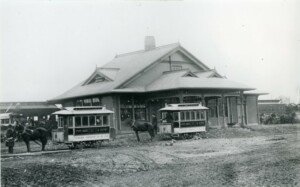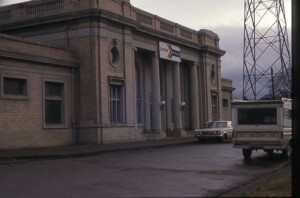Salem’s Railroad Depots
1870 Depot
The Oregon & California Railroad (O&C) reached Salem in October 1870. Although townspeople wanted the station located convenient to the business and residential areas clustered around the riverfront and Commercial Street, they balked at paying the additional $30,000 the railroad wanted for laying track through the city center. So, the O&C depot was built along its north-south route just north of South Mill Creek a mile east of downtown on land obtained from Willamette University.
Early in 1872 some Salem businessmen proposed relocating the depot to a site near Trade and Front Streets, but that idea failed to gain traction. However, in 1880, the O&C extended a spur track westward down Trade Street and erected a freight station on the block bounded by Front, Ferry, Commercial and Trade Streets. Although this provided Salem residents a closer location for shipping and receiving freight, the passenger depot remained distant. On April 14, 1888, the passenger station caught fire and despite the effort of two fire-fighting brigades, it was destroyed.
1888 Depot
Eleven months before the fire, on May 12, 1887, Southern Pacific Company obtained control of the O&C. Because citizens had complained for years about the distance they had to travel to deliver and pick up passengers and their baggage “way out on 12th Street,” the 1888 fire provided SP an opportunity to relocate the station. A new site between Court and Chemeketa Streets was proposed but received little support at a citizens’ meeting held in mid-May to discuss the matter. Before May ended, work had begun on a replacement station 50 feet south of the former depot, and it was opened for use in September of 1888. The new station was an attractive two-story building of Queen Anne architecture, one of only four such depots of that design built by SP. The other three were in California.
In February 1889 the Salem Street Railway Company extended its State Street horse car along 12th to the Southern Pacific depot. Electric trolleys quickly followed. In the early 1890s the growth of Salem and increases in travelers and their luggage began to exceed the capacity of the 1888 depot’s baggage and express room at the south end of the building. A 30-foot-long baggage room extension was completed in early April 1892. For the next 25 years the Queen Anne depot continued serving Salem residents, but its last years were tarnished by negativity in the news media. Starting around 1907, SP began erecting new masonry depots in Oregon cities such as Grants Pass, Roseburg, Eugene, Albany, Corvallis, Willamina, McMinnville, and Forest Grove. This did not go unnoticed by Salem and its newspapers, which in 1916 began to loudly protest that Salem, the state’s capital, should also have a new station. Derisive articles and editorials regularly appeared and on June 8, 1916, the Salem Commercial Club resolved to erect a 24-foot-long sign near the depot reading, “Don’t Judge Our Town By Our Depot.” Thirteen days later, to mend a strained relationship, the club rescinded the resolution. After receiving more than a year of continuous criticism and grousing, SP announced in May 1917 it would build Salem a new station.
On April 6, 1917, the United States entered World War I, which began to create shortages in manpower and materials. It wasn’t until early November of 1917 that SP awarded a contract for constructing the new depot, which was to be at the same location as the 1888 depot. Preparations for relocating the old depot began in late November and on December 6, 1917, it was moved 200 feet north where it continued in service. Construction of the new station was well underway in spring 1918, and it was opened for business with minimal fanfare on September 25, 1918. Afterward, the 1888 depot was demolished except for the baggage/express wing which was moved to a new location just south of the new station (where it is today) to serve as a temporary express office. After the war it was planned to build a new express office matching the architectural style of the 1918 depot. But that plan was never implemented.
It should be noted that there are published accounts asserting the 1888 depot was destroyed by a fire in 1917 on the eve of the United States’ entry into World War I. That is simply untrue.
1918 Passenger Depot
This Beaux-Arts structure conveyed all the ideals of the “gateway to the city”. Passengers entered the station from the west, passing through colossal columns encompassed by large Roman arched windows, to reach the tracks on the east. The building is dominated by a large rectangular central pavilion which houses a 1500-square foot passenger waiting area. Smaller wings house functions including ticketing, baggage and rest rooms. The floor plan of the station reflects the new 20th century need of the women’s waiting room.
The deep west entrance is comprised of four pilaster colonnades, with the four columns directly in front and a three-arched recessed entranceway and double doors at the center. The more shallow trackside entrance incorporates a colonnade of Ionic pilasters with a large metal canopy offering shelter. Decorative plasterwork, coved corner entries, period radiators and Terrazzo marble floor patterns also add to the elegance of the structure.
The concept of the railroad station as a point of civic pride was essential to any city which wished to favorably present its social and cultural merit. Salem, capital city of Oregon, was no exception. The depot was designed by Southern Pacific architect J. H. Christie and built by Stebinger Brothers of Portland for a cost of $25,000. It reflected the importance at the time of making a good impression, worthy of a capital city. The Beaux-Arts Classicism of the new station seemed a natural choice of style for this up-and-coming city. Whistle stop tours brought dignitaries through the community and was a place of gathering to see the famous or infamous traveling through Salem. Competition from Oregon Electric Railway, opened in 1908 between Salem and Portland with a 1912 extension to Eugene, also justified such a grand statement of architectural style.
The 1999 Salem Depot Project by the Oregon Department of Transportation was a full rehabilitation of the 1918 depot. Ceilings and architectural features were restored to their former state. The work also includes improvement of parking facilities, some rail-side pedestrian features such as waiting shelters, lighting and landscaping, and digital status display signs. More information here.
The 1888-92 Baggage/Express Building
South of the 1918 depot is the baggage/express remnant of Salem’s 1888 Queen Anne-style station with its 1892 add-on. When the 1918 depot was complete, the old depot was torn down except for the baggage room which was saved and moved to its present site. Now well over a century old, the former baggage/express wing maintains a high degree of architectural integrity both inside and outside. The exterior continues to display one of the finest features: triangular, scroll-sawn brackets placed among the overhanging eaves surrounding the building. The peak of the roof features gablets or small gables protruding from the end points which tied it to the Queen Anne railroad architecture of the 1888 station.
Original article compiled by Monica Mersinger. Significant updates and corrections provided by R.I. Melbo May 2024.
Bibliography:
Historic Marion, Marion County Historical Society
“Railroad Matters.” Oregon Weekly Statesman 08 July 1870 pg 3 (Historic Oregon Newspapers): “The site for the Railroad Depot was definitely chosen yesterday and is located across Mill Creek, south of the oil mill, on a beautiful piece of gravelly prairie on the road up Mill Creek. This location has been decided by the gift of five and a half blocks of land, by the Trustees of the University, favorably situated for a Depot site, containing about fifteen acres…”
“The O.&C. Depot Burned.” Evening Capital Journal 14 April 1888.









Leave A Comment